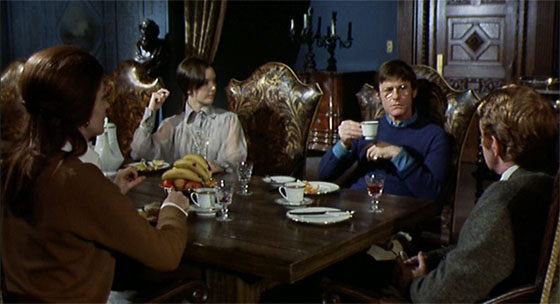 “Welcome to my house. I’m delighted you could come. I’m certain you will find your stay here most illuminating. Think of me as your unseen host, and believe that during your stay here I will be with you in spirit. May you find the answer that you seek. It is here, I promise you. And now, auf Wiedersehen.” – Emeric Belasco, The Legend of Hell House
“Welcome to my house. I’m delighted you could come. I’m certain you will find your stay here most illuminating. Think of me as your unseen host, and believe that during your stay here I will be with you in spirit. May you find the answer that you seek. It is here, I promise you. And now, auf Wiedersehen.” – Emeric Belasco, The Legend of Hell House
Richard Matheson’s 1971 novel Hell House borrowed elements of Shirley Jackson’s The Haunting of Hill House, as well as its film adaptation The Haunting (1963), but with more explicit sex and violence, and more sinister ghosts; it’s a harrowing read, and one which Stephen King has cited as a major influence. A film adaptation quickly followed, directed by John Hough (Twins of Evil), with Matheson writing the screenplay. A more faithful adaptation would warrant an R, but Hough somehow turned in one of the most sexualized PG films ever made. Pay close attention to the active soundtrack and you’ll notice that Hell House is having (female) orgasms for the entire film. Likewise, the central characters are wrestling with psychic, emotional, or sexual repression, and sometimes all three. The house – which, late in the film, is referred to as a psychic battery – charges its occupants with desire, hatred, and insanity. They try to seduce one another; they mistrust one another; they share theories about the haunting, and argue, and drink, and when the table shakes and the cutlery flies lethally through the air, they blame one another for causing it. Like the best haunted house tales, this is less about the house’s ghosts than the psychic baggage borne by the guests. They’re doomed, but they were doomed anyway; the ghosts only hurry their fates.
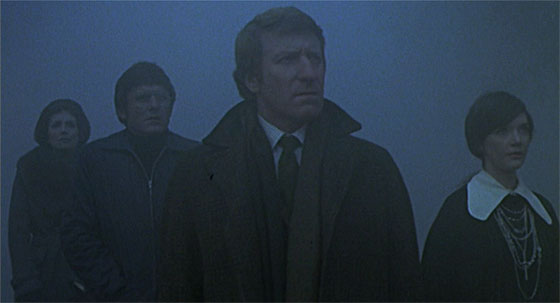
Approaching Belasco House: (L-R) Gayle Hunnicutt, Roddy McDowall, Clive Revill, Pamela Franklin
The cast is small enough to support a chamber drama, spare enough to simplify the story and draw attention to its themes. Roddy McDowall, whom Hough would next use in Dirty Mary Crazy Larry (1974), is Ben Fischer, a “physical medium” who was a young phenom when he first came here, to the Belasco House, in 1953; his fellow psychic investigators were killed or crippled during the investigation. Pamela Franklin (The Innocents, The Nanny) is Florence Tanner, a young and devoutly Christian mental medium. Clive Revill (The Private Life of Sherlock Holmes) plays Dr. Lionel Barrett, a physicist who believes that Belasco House isn’t haunted, just suffused with a psychic energy that awaits validation through science. Regretfully, he decides to bring along his wife, Ann (Gayle Hunnicutt); in the novel we’re made aware of her severe separation anxiety, which provides a better explanation of why she’s come. All of them gather at the house on the invitation of a millionaire who purchased the home from the bankrupt Belasco family; he is giving them five days in the “Mount Everest of haunted houses” to prove there is life after death, with a healthy financial reward awaiting their return. The dark and cavernous house was built by one Emeric Belasco to harbor his decadent, Satanic parties. The windows are bricked up. Erotic art lines every room. There is a blasphemous chapel in one section of the house, giving off such bad psychic vibrations that Florence Tanner can’t bring herself to enter it. A black cat stalks the premises – redundantly.
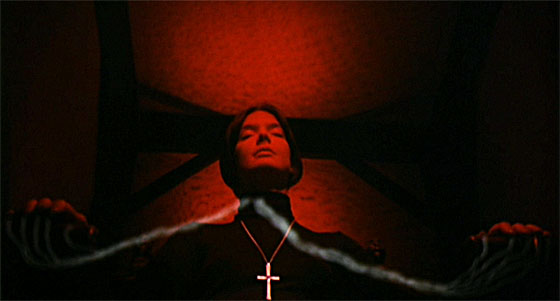
Florence Tanner (Franklin) summons ectoplasm during a psychic sitting.
It doesn’t take long before the authenticity of the hauntings makes itself clear. A phonograph player turns itself on, playing an ominous recording of the late Emeric Belasco welcoming guests to his home. During a psychic sitting, Florence summons a spirit, which warns them to get out of the house, or it will have to hurt them. After this spirit later visits her room, flinging a bedsheet onto her head, she becomes convinced it’s Emeric’s son, whom she calls Daniel; she comes to believe that freeing Daniel’s spirit is key to exorcising the house. Later, during a second sitting, she summons streams of white ectoplasm from her fingertips (in the nineteenth century, some mediums claimed to have this ability), but when Dr. Barrett asks her to leave a sample in a beaker, she shatters it. Over dinner, she throws a tantrum at the doctor, and simultaneously a telepathic pandemonium is unleashed, nearly killing Barrett, and only reinforcing his theory that the house isn’t haunted, but simply choked with a powerful psychic energy that she can tap into. For his part, Fischer remains noncommittal. He warns that the house will try to manipulate them; but he also keeps himself closed psychically to the house’s influence. He would rather remain on the defensive until the week is out and he can collect his money. But Florence’s insistence on recovering Daniel’s body and freeing his spirit sets off a chain of events which prove catastrophic, and Fischer witnesses the events of 1953 re-enacted once more, until finally he decides to open up, remove those thick glasses, and confront Emeric Belasco himself.
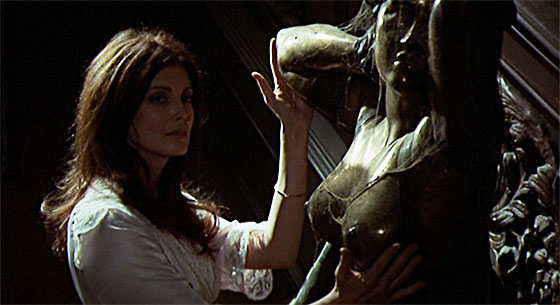
Ann (Hunnicutt), possessed by Belasco House, attempts to seduce Fischer.
The Legend of Hell House is cleverly designed by Matheson to be a mystery which cannot be solved until all sides, with their competing theories, come together. Dr. Barrett, Tanner, and Fischer are each partially correct about what is behind the Hell House hauntings, but only once the body count begins does the answer begin to come clear. Ultimately – and, again, this is slightly clearer in the book – Hell House is as much about impotence and human frailty as it is untethered sexuality. For all its jolts and invisible terrors, this horror story winds its way toward a recognizably human conclusion. Hough does a remarkable job ratcheting up the intensity of his PG-rated film, showcasing his actors with sweaty close-ups and carefully considered lighting, often surrounding them with pitch-black shadows. Those shadows sometimes move, as in one indelible scene in which Ann, lying in bed next to her husband, witnesses the two embracing bodies of an erotic statuette come to writhing life. But the real star is the sound design. An innovative score, throbbing like the heartbeat of a machine, was composed by Brian Hodgson and Delia Derbyshire of the prog/electronic group Electrophon. (In the 60’s, Derbyshire had helped realize Ron Grainer’s iconically otherworldly theme music for Doctor Who.) Just as with The Haunting and, later, The Shining (1980), every moment in this haunted house is filled with unease thanks to an active soundtrack. I can’t imagine getting a good night’s sleep in this house. Apart from the persistent orgasmic moaning, restless noises drift from down the corridors and beyond the walls; the psychic ability of Florence Tanner is effectively reproduced with half-heard whispers in her bedroom, which she interprets to be the voice of Daniel Belasco. All of this works in the way a haunted house movie ought to, playing upon the viewer’s fears of dark cellars and corridors, and strange noises in the middle of the night. Since the windows are bricked up, it’s always the middle of the night in Hell House.
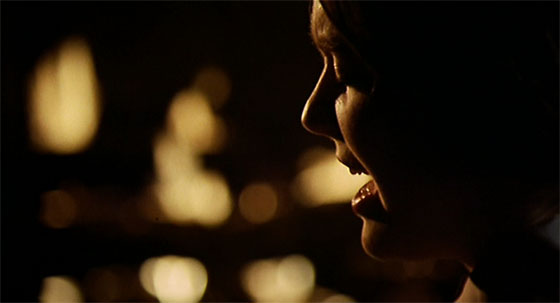
Belasco - Emeric, or Daniel? - uses the body of Florence Tanner to warn the guests to leave.
So, as much as one could wish the film had been rated R, for a low budget AIP picture of the early 70’s, this is pretty well done. Its influence can be felt from The Shining to Edgar Wright’s loving homage in “Don’t!” (for Grindhouse). The ending has always felt a bit anticlimactic to me, though over multiple viewings I’ve come to appreciate it (or perhaps grown used to it). McDowall’s neurotic style of performance wouldn’t be showcased as well until 1985’s Fright Night; that would make for a fine double feature. Here, he’s well matched by both Revill and Franklin, as the three duel for authority in Belasco House. Horror fans will smile at an unexpected cameo by the veteran British actor Michael Gough. The Region 1 DVD, released in 1999 by 20th Century Fox, is ill-considered from the cover (which contains a major spoiler) to the extras (a trailer for the Adam West Batman film, for no reason); however, where it counts – in the presentation of the film – the disc is superb and in no need of an upgrade. Watched on a large-screen TV, you can see the skin blemishes of the actors in Hough’s extreme close-ups; the colors pop and the shadows are a deep black. All this just makes it easy to become absorbed by Hell House again.









